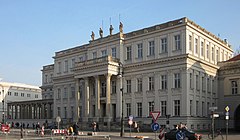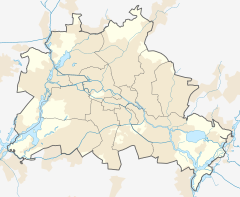Kronprinzenpalais
| Kronprinzenpalais | |
|---|---|

Kronprinzenpalais, 2011
|
|
|
Location in Berlin
|
|
| Former names | Königliches Palais |
| General information | |
| Type | Palace |
| Architectural style | Neoclassical |
| Town or city | Berlin |
| Country | Germany |
| Coordinates | 52°31′01″N 13°23′46″E / 52.517°N 13.396°E |
| Construction started | 1663 |
| Completed | 1669 |
| Renovated | 1732,1856-57, 1968-69 (rebuild) |
| Design and construction | |
| Architect |
Johann Arnold Nering Philipp Gerlach Johann Heinrich Strack others |
The Kronprinzenpalais (Crown Prince's Palace) is a landmark late Neoclassical-style building at one end of Unter den Linden in Berlin. It was a palace of the ruling Hohenzollern house of Prussia until the abolition of the monarchy at the end of World War I. It then became an annexe of the Berlin National Gallery, housing a preeminent collection of modern art. It was closed by the Nazis and the building was destroyed in World War II. It was rebuilt in 1968 and used by East Germany as a guest house for official visitors to their capital of East Berlin. Since German reunification it has been used for exhibitions and cultural events.
Johann Arnold Nering created the building in 1663–69 as the private residence of Cabinet Secretary Johann Martitz, converting an existing middle-class house. From 1706 to 1732, it was the official residence of the Governor of Berlin.
In 1732, Philipp Gerlach remodelled the building in baroque style with a protruding central bay and a carriage drive rising to the front entrance, to serve as a residence for the Crown Prince, the future King Frederick II. He and his wife Elisabeth Christine stayed there only intermittently before his accession to the throne in 1740, after which he took up residence in part of the royal palace. He gave the Kronprinzenpalais to his brother Augustus William; after Augustus William's death in 1758, his widow continued to use it until 1780.
...
Wikipedia

